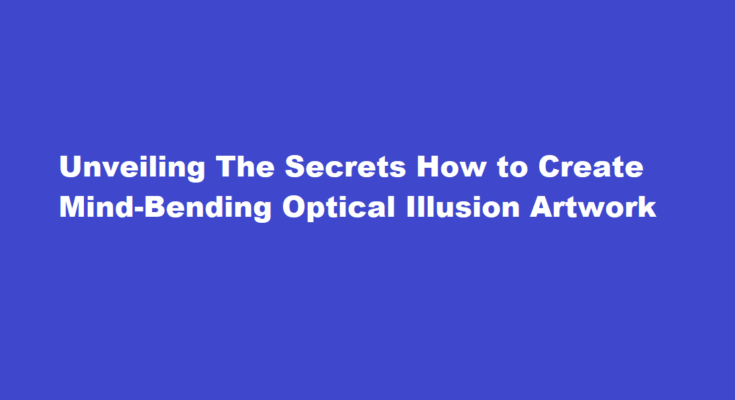Introduction
Optical illusion artwork has captivated and bewildered audiences for centuries. Artists use clever techniques to deceive the human eye and create captivating illusions that challenge our perception of reality. Whether you’re a seasoned artist or a beginner, learning the secrets behind crafting mind-bending optical illusions can elevate your artistic prowess. In this article, we will delve into the fascinating world of optical illusion art, uncovering the principles and techniques that enable artists to create stunning and unforgettable visual experiences.
Understanding Optical Illusions
Before delving into the creation process, let’s briefly explore what optical illusions are and why they work. Optical illusions are visual stimuli that trick our brains into perceiving something different from what is actually present. These illusions are a result of how our brain interprets the information received from our eyes, often relying on shortcuts and assumptions to make sense of the world around us.
Artists leverage this phenomenon to create artworks that defy logic and reality, leaving viewers in awe and wonder. By manipulating perspective, geometry, color, and patterns, they can induce effects like movement, 3D depth, and shape-shifting in 2D images, producing mind-bending optical illusion artwork.
Key Elements in Creating Optical Illusions
Geometry and Perspective
To begin crafting your optical illusion artwork, master the art of manipulating geometry and perspective. Linear perspective, for instance, allows you to create an illusion of depth in a 2D space. Understanding vanishing points and horizon lines will enable you to make objects appear closer or farther away, providing a foundation for immersive illusions.
Contrasting Colors and Shapes
Contrast plays a significant role in creating optical illusions. By using contrasting colors and shapes, artists can make objects stand out or recede in the eyes of the viewer. Experiment with complementary colors, such as blue and orange or yellow and purple, to create striking effects that pop out of the canvas.
Anamorphosis
Anamorphic illusions are among the most mind-bending and intriguing forms of optical art. This technique involves distorting an image in such a way that it appears recognizable only when viewed from a specific angle or with the aid of reflective surfaces. To create anamorphic artwork, artists often use grids or software to distort their images before accurately projecting them onto the final canvas.
Ambiguous Figures
Playing with ambiguous figures can lead to astonishing results. These are images that can be interpreted in multiple ways, causing the viewer’s perception to oscillate between different interpretations. By skillfully blending two or more images, an artist can create mesmerizing illusions that challenge the viewer’s understanding of the composition.
Moiré Patterns
Moiré patterns are captivating visual effects produced when overlapping patterns with slight variations in spacing are superimposed. By carefully aligning and manipulating these patterns, artists can create dynamic and ever-changing illusions of movement and texture.
Trompe-l’oeil
The art of trompe-l’oeil, meaning “deceive the eye” in French, involves creating realistic images that give the impression of three-dimensionality on a two-dimensional surface. Masters of this technique can make objects appear to pop out of the canvas, blend seamlessly with reality, or even extend into the environment around the artwork.
Practical Tips for Crafting Optical Illusions
Plan Your Illusion
Before putting paint to canvas or pen to paper, meticulously plan your optical illusion artwork. Sketch out your ideas, experiment with various compositions, and decide on the techniques you wish to employ. Proper planning will save time and effort in the execution phase.
Use High-Quality Materials
For your optical illusion artwork to have the desired impact, work with high-quality materials. This will ensure that colors remain vibrant, lines are crisp, and the overall effect is striking.
Pay Attention to Lighting
Lighting can significantly affect how an optical illusion is perceived. Consider the direction and intensity of light in the location where the artwork will be displayed. Shadows and highlights can enhance or detract from the illusion’s impact.
Test and Refine
As you work on your optical illusion, take breaks to step back and observe the artwork from various angles. This will allow you to assess the effectiveness of the illusion and make necessary adjustments. Seek feedback from others to gain new perspectives and insights.
FREQUENTLY ASKED QUESTIONS
How do optical illusions trick the mind?
Optical illusions happen when our brain and eyes try to speak to each other in simple language but the interpretation gets a bit mixed-up. For example, it thinks our eyes told it something is moving but that’s not what the eyes meant to say to the brain.
What are the 3 types of optical illusions?
There are three main types of optical illusions including literal illusions, physiological illusions and cognitive illusions. All three types of illusions have one common thread. The perception of the image given to the brain doesn’t measure up.
Conclusion
Creating mind-bending optical illusion artwork requires a combination of artistic skill, an understanding of visual perception, and a willingness to experiment. By mastering the principles of geometry, perspective, contrast, and various illusion techniques, artists can amaze and challenge viewers with their creations. So, unleash your imagination, embrace the unexpected, and embark on a journey into the mesmerizing world of optical illusion art. With dedication and practice, you too can craft artwork that leaves spectators awestruck, questioning their senses, and craving more visual wonders.
Read Also : The Enchanting Guide Training Your Pet Parrot to Perform a Magic Trick



